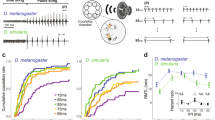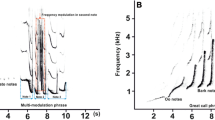Abstract
MALES of most species of katydids (Orthoptera, Tettigoniidae) make calling songs that attract conspecific females1–4. These songs, like those of crickets, cicadas, and some grasshoppers, are species specific and can be produced in perfect form by males that have never heard a similar song5. The fact that insect calling songs are the same even though conditions during their development varied from generation to generation and between field and laboratory has led to the inference that the ontogeny of such songs is free of environmental modification6. We show here, however, that the calling songs of a katydid are dimorphic and photoperiodically determined.
This is a preview of subscription content, access via your institution
Access options
Subscribe to this journal
Receive 51 print issues and online access
$199.00 per year
only $3.90 per issue
Buy this article
- Purchase on Springer Link
- Instant access to full article PDF
Prices may be subject to local taxes which are calculated during checkout
Similar content being viewed by others
References
Busnel, R. G., Dumortier, B. & Busnel, M. C. Bull. Biol. France Belgique 90, 219–286 (1956).
Spooner, J. D. Anim. Behav. 16, 197–212 (1968).
Bailey, W. J. & Robinson, D. Anim. Behav. 19, 390–397 (1971).
Morris, G. K., Kerr, G. & Gwynne, D. Can. J. Zool. 53, 1127–1130 (1975).
Alexander, R. D. in Animal Communication (ed. Sebeok, T. A.) 167–216 (Indiana University Press, Bloomington, 1968).
Walker, T. J. Evolution 16, 407–428 (1962).
Walker, T. J. Am. Zool. 14, 1137–1150 (1974).
Thomas, E. S. & Alexander, R. D. Occ. Papers Mus. Zool. Univ. Mich., 626, 1–31 (1962).
Walker, T. J., Whitesell, J. J. & Alexander, R. D. Ohio J. Sci. 73, 321–330 (1973).
Bailey, W. J. Bull. I.F.A.N. 37, 171–226 (1975).
Walker, T. J. J. Comp. Physiol. 101, 57–69 (1975).
Walker, T. J. Ann. Ent. Soc. Am. 50, 626–636 (1957).
Bailey, W. J. & Robinson, D. Anim. Behav. 19, 390–397 (1971).
Walker, T. J. Q. Rev. Biol. 39, 345–355 (1964).
Whitesell, J. J. thesis, Univ. Florida (1974).
Walker, T. J. J. Insect Physiol. 21, 595–603 (1975).
Walker, T. J. Ann. Ent. Soc. Am. 68, 607–611 (1975).
Beck, S. D. Insect Photoperiodism (Academic, New York, 1968).
Author information
Authors and Affiliations
Rights and permissions
About this article
Cite this article
WHITESELL, J., WALKER, T. Photoperiodically determined dimorphic calling songs in a katydid. Nature 274, 887–888 (1978). https://doi.org/10.1038/274887a0
Received:
Accepted:
Issue Date:
DOI: https://doi.org/10.1038/274887a0
This article is cited by
-
Female adaptation to developmental plasticity in male calling behavior
Behavioral Ecology and Sociobiology (2010)
Comments
By submitting a comment you agree to abide by our Terms and Community Guidelines. If you find something abusive or that does not comply with our terms or guidelines please flag it as inappropriate.



